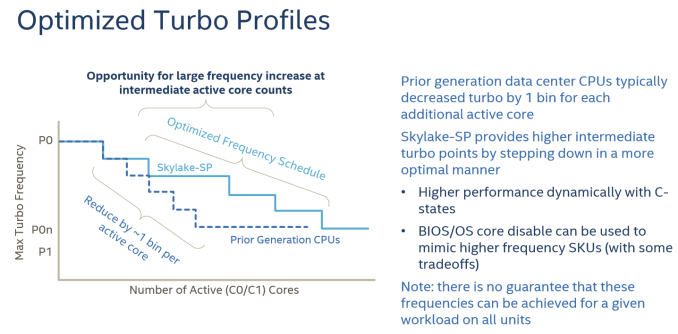Sizing Up Servers: Intel's Skylake-SP Xeon versus AMD's EPYC 7000 - The Server CPU Battle of the Decade?
by Johan De Gelas & Ian Cutress on July 11, 2017 12:15 PM EST- Posted in
- CPUs
- AMD
- Intel
- Xeon
- Enterprise
- Skylake
- Zen
- Naples
- Skylake-SP
- EPYC
Intel's Optimized Turbo Profiles
Also new to Skylake-SP, Intel has also further enhanced turbo boosting.
There are also some security and virtualization enhancements (MBE, PPK, MPX) , but these are beyond the scope this article as we don't test them.
Summing It All Up: How Skylake-SP and Zen Compare
The table below shows you the differences in a nutshell.
| AMD EPYC 7000 |
Intel Skylake-SP | Intel Broadwell-EP |
|
| Package & Dies | Four dies in one MCM | Monolithic | Monolithic |
| Die size | 4x 195 mm² | 677 mm² | 456 mm² |
| On-Chip Topology | Infinity Fabric (1-Hop Max) |
Mesh | Dual Ring |
| Socket configuration | 1-2S | 1-8S ("Platinum") | 1-2S |
| Interconnect (Max.) Bandwidth (*)(Max.) |
4x16 (64) PCIe lanes 4x 37.9 GB/s |
3x UPI 20 lanes 3x 41.6 GB/s |
2x QPI 20 lanes 2x 38.4 GB/s |
| TDP | 120-180W | 70-205W | 55-145W |
| 8-32 | 4-28 | 4-22 | |
| LLC (max.) | 64MB (8x8 MB) | 38.5 MB | 55 MB |
| Max. Memory | 2 TB | 1.5 TB | 1.5 TB |
| Memory subsystem Fastest sup. DRAM |
8 channels DDR4-2666 |
6 channels DDR4-2666 |
4 channels DDR4-2400 |
| PCIe Per CPU in a 2P |
64 PCIe (available) | 48 PCIe 3.0 | 40 PCIe 3.0 |
(*) total bandwidth (bidirectional)
At a high level, I would argue that Intel has the most advanced multi-core topology, as they're capable of integrating up to 28 cores in a mesh. The mesh topology will allow Intel to add more cores in future generations while scaling consistently in most applications. The last level cache has a decent latency and can accommodate applications with a massive memory footprint. The latency difference between accessing a local L3-cache chunk and one further away is negligible on average, allowing the L3-cache to be a central storage for fast data synchronization between the L2-caches. However, the highest performing Xeons are huge, and thus expensive to manufacture.
AMD's MCM approach is much cheaper to manufacture. Peak memory bandwidth and capacity is quite a bit higher with 4 dies and 2 memory channels per die. However, there is no central last level cache that can perform low latency data coordination between the L2-caches of the different cores (except inside one CCX). The eight 8 MB L3-caches acts like - relatively low latency - spill over caches for the 32 L2-caches on one chip.

















219 Comments
View All Comments
JKflipflop98 - Wednesday, July 12, 2017 - link
For years I thought you were just really committed to playing the "dumb AMD fanbot" schtick for laughs. It's infinitely more funny now that I know you've actually been *serious* this entire time.ddriver - Wednesday, July 12, 2017 - link
Whatever helps you feel better about yourself ;) I bet it is funny now, that AT have to carefully devise intel biased benches and lie in its reviews in hopes intel at least saves face. BTW I don't have a single amd CPU running ATM.WinterCharm - Thursday, July 13, 2017 - link
Uh, what are you smoking? this is a pretty even piece.boozed - Tuesday, July 11, 2017 - link
You haven't done your job properly unless you've annoyed the fanboys (and perhaps even fangirls) for both sides!JohanAnandtech - Wednesday, July 12, 2017 - link
Wise words. Indeed :-)Ranger1065 - Wednesday, July 12, 2017 - link
If you are referring to ddriver, I agree, wise words indeed.ddriver - Wednesday, July 12, 2017 - link
Well, that assumption rests on the presumption that the point of reviews is to upsed fanboys.I'd say that a "review done right" would include different workload scenarios, there is nothing wrong with having one that will show the benefits of intel's approach to doing server chips, but that should be properly denoted, and should be just one of several database tests and should be accompanied by gigabytes of databases which is what we use in real world scenarios.
CoachAub - Wednesday, July 12, 2017 - link
It was mentioned more than once that this review was rushed to make a deadline and that the suite of benchmarks were not everything they wanted to run and without optimizations or even the usual tweaks an end-user would make to their system. So, keep that in mind as you argue over the tests and different scenarios, etc.ddriver - Thursday, July 13, 2017 - link
It doesn't take a lot of time to populate a larger database so that you can make a benchmark that involves an actual real world usage scenario. It wasn't the "rushing" that prompted the choice of database size...mpbello - Friday, July 14, 2017 - link
If you are rushing, you reduce scope and deliver fewer pieces with high quality instead of insisting on delivering a full set of benchmarks that you are not sure about its quality.The article came to a very strong conclusion: Intel is better for database scenarios. Whatever you do, whether you are rushing or not, you cannot state something like that if the benchmarks supporting your conclusion are not well designed.
So I agree that the design of the DB benchmark was incredibly weak to sustain such an important conclusion that Intel is the best choice for DB applications.